Mob Farms are structures built to acquire mob drops more easily and in larger numbers. They usually consist of two components, the farm itself, a large and dark room to spawn mobs and funnel them into a central location, and a Mob Grinder to kill them quickly and efficiently.
Locations
The purpose for the farm is to provide a large area that is a viable spawn position for the intended targets, and to kill the mobs quickly. Due to the rules Minecraft applies to spawning mobs, this makes the choice of a location for the mob farm a difficult topic.
Farms placed on the surface can provide good drop rates during the day, when it is one of the few spots of dark ground, but has a sharp drop in effectiveness during nighttime, when the entire surface is dark enough to support mob spawning.
Farms built underground have a time-independent drop rate, and will remain within your personal spawn range for hostiles when you go mining, but their effectiveness depends on the amount of unlit caverns in your vicinity, which provide alternative places for mobs to spawn.
Farms floating high in the sky can achieve record spawn rates in both night and day, as they represent the only viable spawn ground. However, building one in survival is rather suicidal, and due to their height they will stop working completely when you descend underground to mine resources. To produce loot, you have to stay at the height of the farm.
Farms constructed under an ocean can provide the best of all worlds, as the ocean limits the viable spawn locations to open areas underground, and there are fewer natural caves to compete with. You can also locate your mine below it to ensure you will always be close enough to spawn monsters.
Superflat worlds will provide higher spawn rates than other worlds, as the missing air pockets underground reduce the amount of parasitic dark places.
The Nether is difficult to farm, as water evaporates and all mobs are immune to fire. This reduces the amount of functioning farm designs considerably. Lava cannot be used for transport because mobs are not pushed by it. One could try to funnel the mobs through Nether Portals to circumvent the restrictions.
Drops
What a mob farm produces depends on location and the type of grinder used to kill the mobs. Automatic killing will prevent rare drops and experience, but is safer as the player is not required to be near the mobs. Following is a table with mobs that can be effectively farmed and their usual and player-caused drops. Player caused drops, as well as experience, can only be obtained when the monster is killed manually.
| Mob | Normal Drops | Player–Caused Drops | Notes |
|---|---|---|---|
| Creeper | Gunpowder | Music Disc | Music Discs only drop when a skeleton kills a creeper. |
| Enderman | Ender Pearl | None | Does not work with water-based farms. Can break farms with randomly taken or placed blocks. |
| Skeleton | Arrow Bone |
Bow Random Armor Pumpkin Jack o'Lantern | |
| Slime | Slimeball | None | Does not swim upwards in water.(in versions before 14w05a; The A.I. was updated at this point) Large slimes can clog up passages. Only spawns in Swamp biomes or in certain chunks at level 39 or below. |
| Spider | String | Spider Eye | Wall-climbing can clog up passages. |
| Cave Spider | String | Spider Eye | Wall-climbing can clog up passages. (Only at Mineshafts) |
| Wither Skeleton | Coal Bone |
Wither Skeleton Skull Stone Sword Random Armor Pumpkin Jack o'Lantern |
Nether Mob. Only spawns within fortresses. |
| Zombie | Rotten Flesh | Iron Ingot Carrot Potato Iron Shovel Iron Sword Random Armor Pumpkin Jack o'Lantern |
Baby zombie variant. Is twice as fast, and 1 block tall making some kill methods impractical, and some farm designs "leaky." |
| Zombie Pigman | Rotten Flesh Gold Nugget |
Gold Ingot Golden Sword Random Armor Pumpkin Jack o'Lantern |
Can be farmed in the Nether, or in the Overworld, as they spawn near Nether Portals. Also, the same problem with normal baby zombies apply. |
| Witch | Glass Bottle Glowstone Dust Redstone Dust Spider Eye Stick Sugar Gunpowder |
Potion of Healing Potion of Fire Resistance Potion of Swiftness |
Can be farmed in Swamp Huts during world gen and when it is dark. |
| Blaze | None | Glowstone Dust (Only on Xbox , PS3 and PS4 Edition) Blaze Rod |
Can be farmed in Nether Fortress or Spawners. |
| Magma Cube | Magma Cream | None | Can be farmed in Nether. |
| Ghast | Gunpowder Ghast Tear |
None | Can be farmed in Nether. |
| Silverfish | None | None | Can be farmed in strongholds Spawners. Ability to hide in blocks could potentially cause damage to farm if made of cobblestone or stone. |
Designs
When planning a mob farm, one should always consider the necessary size, which depends on where one plans to be in relation to the area. If you plan to be directly beneath the center of the farm, waiting for the items, the radius in which mobs would spawn can be easily used to calculate the size of the farm:
floor( sqrt(1024 - (Spawn Floor Height - Collection Floor Height)^2 )) = Spawn Room Radius
If you plan to spend your time in a less defined position, it might be easier to stack a simple design several times, ensuring that at least some areas are in the spawn range while limiting complexity.
Sinkhole
The easiest possible design consists of a large, empty area of simple shape, with one or more holes in the ground for the mobs to drop through. The edge of each hole has to be lined with opened trapdoors or gates to trick the Mob AI into believing the hole to be solid ground. As of minecraft 1.4, signs no longer trick the mob AI. Trapdoors can also be controlled with Redstone, so one could shut off the farm by closing the holes remotely.
The whole room is closed by a roof to create minimal light level. A roof height of 3 allows Endermen to spawn, while a roof height of 1 would restrict the farm to spiders.
Sinkhole farms are naturally not very effective, as the chance for a mob to wander into a hole is small, and zero when the player is so far away that the mobs freeze. But they can be built quickly and cheaply and will work in the Nether as well.
Canal-Style
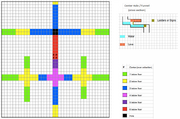
Example layout of a 38x38 Canal-Style farm
To improve the chances of a mob falling into the holes, one can add channels filled with flowing water, leading to the central hole. The channels are lined with open trapdoors to trick the mobs into falling in, and the water transports them into the grinders. Such a design requires a bit of planning to ensure that there is no stationary water in which the mobs might get stuck, reducing effectiveness.
Since the system uses water to transport mobs, it will fail to capture Endermen, which teleport away when touching water. Therefore, the roof of the cavern should be 2 blocks above the ground to prevent griefing of your farm by Endermen taking blocks.
Compact Canal Design
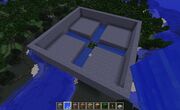
Compact Canal design
A very easily built design can be made in an 20x20 area, using eight water source triangles to fill the channels, which are exactly eight blocks long so that the water stops exactly at the edges of the central hole. The design can be easily stacked or placed next to each other to increase the effectiveness.
Minimal Canal Design
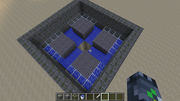
Minimal Canal design, using glass to show the flow of water
If there is not enough space for larger designs, this might be used. Its small size of 10x10 (inner area) makes it able to be incorporated into larger construction projects without trouble. It uses four water source blocks, one in each corner, with the water flowing around 3x3 squares of building material to the central hole. The parts of the water between the wall and the blocks is closed over to provide more spawning area.
Large Chamber Fully Automatic Design
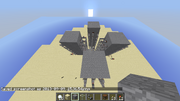
Large Chamber Fully Automatic
This is a very large farm that requires a lot of resources, it has 6 spawn chambers in each building, and redstone controlling it. It produces 4 waves of average 10-15 mobs every 16 or so seconds
Active Mob Displacement
The Canal-Style System still suffer from the mobs freezing when outside a certain range around your character. Active Systems can correct that problem, using Redstone and Dispensers filled with a Water bucket to flood the spawning grounds repeatedly, flushing all mobs into the channels to be transported to the grinders. Thus, the farm provides area for the mobs to spawn in, but does not rely on mob movement to get them into the grinder. Using this, one can omit the trapdoors needed for the other, passive designs.
A good example of this kind of farm can be seen here, stacking the same basic design several times and using fall damage as grinder.
Another design doesn't push mobs into a tube. However, the rates are over 10,000 per hour.
Villager
This method only works on Zombies because no other mob is attracted to Villagers. This is tricky, as you need a Village to get the Villager into the right position. This method works by having a straight line from the zombie spawner in a straight line next to where the villagers are and having a method of killing at the end next to the villager (e.g. water, fall damage, etc.).
Other Designs
Instead of using water to transport mobs, there are various other methods to make them move towards the grinder, all of which may work better with certain mobs, but can have higher resource requirements or lesser gathering rates.
For example, this system uses pistons as well as active grinding to also collect XP:
One-Way Doors
Relying on the random movement of mobs, One-Way Door Designs use doors or pistons to prevent the mobs from wandering backwards. Making several sets of doors can increase the speed with which the mobs move towards the hole.
The easiest configuration consists of a wall of doors (Iron on Hard difficulty to prevent Zombies from smashing them, or fencegates, or maybe trapdoors somehow. Use wooden doors on other difficulties) with a row of pressure plates in front of them. When the mobs walk onto the pressure plates, the door opens, letting them through, but once on the other side, they can't open the door since there is no switch.
With Pistons, the arrangement is reversed, with the pressure plates on the desired side, and the pistons pointing upwards, so that they block the path of the mobs when extended. This design only work with a 2-block high roof to prevent the mobs from jumping, and even then might fail on spiders. However, it requires considerably more common ingredients than the iron door variant.
Such systems can also be used to "store" mobs after gathering them from the farm, so that they later can be killed for the rare drops and experience.
Slime
If you want an extremely good mob farm, this is the one for you. It utilizes the largest natural slime to push the mobs off the platform. The simplest way to get these slimes are through a slime farm. As for the rates, it gets over 20,000 items per hour, as said in the video title.
Transporting Mobs
After collecting the mobs from the farm, it might be beneficial to transport them to a different location before grinding them, so that you can access the items more easily while remaining at a close-to optimal position for the spawning of your farms.
Horizontal Transportation
Horizontal Transportation can be done easily using flowing water, with a drop of 1 block vertically for every 8 block travelled horizontally. Build a tunnel with a height of 3 blocks and a width equal to the size of your gathering holes (usually 2). Mine forward to a length of 8 Blocks, so that water placed at the start ends exactly at the drop. Repeat, but one block lower, so that the creeps fall from one funnel part to the next. Mine out the roof at the higher level for 2 or 3 more block to prevent spider clinging to the walls from clogging up the funnel.
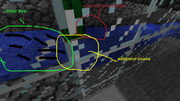
Spider grinder
Alternatively, one can use a cactus to grind the spiders immediately. To do this, make the first funnel part only 7 block long and place only one water source block instead of two. Place a sand block and a cactus on top on the same side as the source block. To place the cactus, you have to mine out the block next to it. To ensure the water flow on the next part, mine out the wall block next to the sand and add the water sources there and next to the sand, where there would usually be one.
Downward transportation
Transporting mobs and items downward is trivial, simply let them drop down a chute with a water brake at the bottom. Or omit the water brake when you want the mobs to die from fall damage.
Upward transportation
Upward transportation uses the fact that nearly all mobs will attempt to swim in water, moving upwards. Therefore, to get the mobs moving upwards, one has to provide only a column of water with enough air holes to prevent them from drowning. This can be done by arranging signs or ladders and water source blocks in the following vertical configuration:
This can be repeated indefinitely in any direction for a mob elevator. When arriving at the right height, flowing water on top of the topmost ladder is enough to dislodge them.
However, one should remember that Items will sink in water. Hoppers can be placed at the bottom of a vertical transportation column to collect items that enter the column. In addition, Slimes will not swim in versions prior to Minecraft 1.8, which can be used to separate them from other mobs.
Grinding
The last part of a mob farm is to kill the gathered mobs and collect their items. This can be done in different ways, using the variety of damage available in Minecraft, like falling, suffocating, drowning, burning, sunlight (for undead), touching cacti or simply player-applied damage from weapons.
Passive Systems do not change to kill the mobs, they rely on constantly available damage sources . The most common mob grinders, the "Lava Blade" and "Drowning Trap" fall in this category.
Active Systems have to change configuration to actually kill mobs, usually in the form of redstone devices. The most known might be the "Piston Grinder", which applies suffocation damage by pushing an opaque block into the head of the mob. While possibly faster than passive systems in killing, active systems usually have a limited capacity, and higher amounts of mobs might clog or even jam the system. The "Minecart Grinder" uses Minecarts to carry the mobs into one block high space, suffocating them. This method can jam up too, but is fairly amusing.
EXP farms are systems that capture and soften up the mobs, but rely on the player to deliver the killing blow, so that the rare drops and experience can be gathered. An example would be a nearly-lethal falling height which would reduce the majority of mobs to half a heart, easily killed even without a weapon. However, such systems are only as good as the player using them, and in constant danger of being destroyed by creepers if not built out of obsidian, or if the player is out of sight of the creeper, in which case it will not explode.
With the Hopper, it becomes easy to collect the dropped items, even without player interference. This makes fully automatic mob farms possible where the loot will be deposited in a chest for easy accessibility.
Video
Tutorials/Mob farm/video
